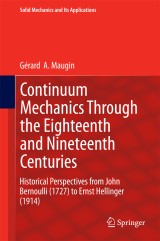Details

Continuum Mechanics Through the Eighteenth and Nineteenth Centuries
Historical Perspectives from John Bernoulli (1727) to Ernst Hellinger (1914)Solid Mechanics and Its Applications, Band 214
|
96,29 € |
|
| Verlag: | Springer |
| Format: | |
| Veröffentl.: | 04.04.2014 |
| ISBN/EAN: | 9783319053745 |
| Sprache: | englisch |
Dieses eBook enthält ein Wasserzeichen.
Beschreibungen
<p>Conceived as a series of more or less autonomous essays, the present book critically exposes the initial developments of continuum thermo-mechanics in a post Newtonian period extending from the creative works of the Bernoullis to the First World war, i.e., roughly during first the “Age of reason” and next the “Birth of the modern world”. The emphasis is rightly placed on the original contributions from the “Continental” scientists (the Bernoulli family, Euler, d’Alembert, Lagrange, Cauchy, Piola, Duhamel, Neumann, Clebsch, Kirchhoff, Helmholtz, Saint-Venant, Boussinesq, the Cosserat brothers, Caratheodory) in competition with their British peers (Green, Kelvin, Stokes, Maxwell, Rayleigh, Love,..). It underlines the main breakthroughs as well as the secondary ones. It highlights the role of scientists who left essential prints in this history of scientific ideas. The book shows how the formidable developments that blossomed in the twentieth century (and perused in a previous book of the author in the same Springer Series: “Continuum Mechanics through the Twentieth Century”, Springer 2013) found rich compost in the constructive foundational achievements of the eighteenth and nineteenth centuries. The pre-WWI situation is well summarized by a thorough analysis of treatises (Appell, Hellinger) published at that time. English translations by the author of most critical texts in French or German are given to the benefit of the readers.</p>
<p>1 General Introduction: About the Contents and Form of this Book.- 2 A Glimpse at the Eighteenth Century: From John Bernoulli to Lagrange.- 3 What Happened on September 30, 1822, and What Were its Implications for the Future of Continuum Mechanics?.- 4 Piola and Kirchhoff: On Changes of Configurations.- 5 Duhamel’s Pioneering Work in Thermo-elasticity and Its Legacy.- 6 From Cauchy to Boussinesq via Barré de Saint-Venant.- 7 Helmholtz Interpreted and Applied by Duhem.- 8 About the Cosserats’ Book of 1909.- 9 Caratheodory: Thermodynamics and Topology.- 10 On Duhem’s Energetics or General Thermodynamics.- 11 A Course of Continuum Mechanics at the Dawn of the Twentieth Century (Volume III of Appell’s Treatise on Rational Mechanics).- 12 A Successful Attempt at a Synthetic View of Continuum Mechanics on the Eve of WWI: Hellinger’s Article in the German Encyclopaedia of Mathematics.- 13 Epilogue.- Retrospective: A Gallery of Portraits of the Main Actors.</p><p> <br> <br></p>
<p>Conceived as a series of more or less autonomous essays, the present book critically exposes the initial developments of continuum thermo-mechanics in a post Newtonian period extending from the creative works of the Bernoullis to the First World war, i.e., roughly during first the “Age of reason” and next the “Birth of the modern world”. The emphasis is rightly placed on the original contributions from the “Continental” scientists (the Bernoulli family, Euler, d’Alembert, Lagrange, Cauchy, Piola, Duhamel, Neumann, Clebsch, Kirchhoff, Helmholtz, Saint-Venant, Boussinesq, the Cosserat brothers, Caratheodory) in competition with their British peers (Green, Kelvin, Stokes, Maxwell, Rayleigh, Love,..). It underlines the main breakthroughs as well as the secondary ones. It highlights the role of scientists who left essential prints in this history of scientific ideas. The book shows how the formidable developments that blossomed in the twentieth century (and perused in a previous book of the author in the same Springer Series: “Continuum Mechanics through the Twentieth Century”, Springer 2013) found rich compost in the constructive foundational achievements of the eighteenth and nineteenth centuries. The pre-WWI situation is well summarized by a thorough analysis of treatises (Appell, Hellinger) published at that time. English translations by the author of most critical texts in French or German are given to the benefit of the readers.</p>
Thorough analysis of the expansion of the principles of mechanics after Newton until WWI Rational exposition of the development of the notion of stress and energy-related quantities Historical perspective based on the analysis of original authors (with English translation of texts where needed) Includes supplementary material: sn.pub/extras
Diese Produkte könnten Sie auch interessieren:

Neutron Applications in Earth, Energy and Environmental Sciences

von: Liyuan Liang, Romano Rinaldi, Helmut Schober

149,79 €

Nanobioelectronics - for Electronics, Biology, and Medicine

von: Andreas Offenhäusser, Ross Rinaldi

96,29 €














